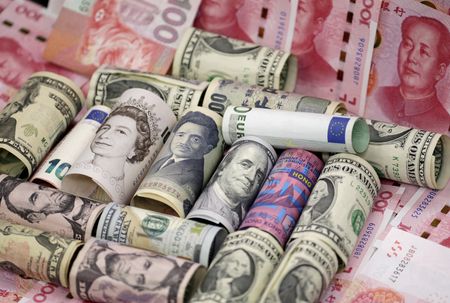By Ankur Banerjee
SINGAPORE (Reuters) -The U.S. dollar rose sharply and then steadied on Wednesday as President Donald Trump backed away from threats of firing Federal Reserve Chair Jerome Powell in a relief to investors, while optimism around trade deals lifted beaten-down sentiment.
The markets this week have been grappling with the notion that the Fed’s independence could be under threat after repeated attacks by Trump on Powell for not cutting rates since the president resumed office in January.
But late on Tuesday Trump appeared to back down.
“I have no intention of firing him,” Trump told reporters in the Oval Office on Tuesday. “I would like to see him be a little more active in terms of his idea to lower interest rates.”
That left the dollar rising rapidly at the start of the trading day in Asian hours, but it steadied by mid-afternoon ahead of the European open.
The dollar rose more than 1% against the yen to 143.21 in early trading and was last slightly stronger at 141.85. Against the Swiss franc, the dollar was last 0.4% stronger at 0.8222, having jumped more than 1% earlier in the session.
The euro eased 0.2% to $1.1393, while sterling was down 0.15% at $1.3313.
The dollar had been trading near multi-year lows versus the euro and the Swiss franc on Tuesday, while the yen hit a seven-month high as investors dumped U.S. assets, worried by trade tensions and Trump’s attacks on the Fed.
Prashant Newnaha, senior Asia-Pacific rates strategist at TD Securities, said that the odds were low that Trump could remove Powell from office but that his comments on the Fed chair and China were “music to the market’s ears”.
“Markets are realizing the administration cannot afford to let asset prices crash, and this is drawing in the dip buyers,” Newnaha said. “For now, Trump views propping up markets as providing him with policy leverage.”
Also aiding sentiment on Wednesday were comments from Trump and U.S. Treasury Secretary Scott Bessent that suggested that there could be a de-escalation in U.S.-China trade tensions and any trade deal with China could “substantially” cut tariffs.
“Trade is the bigger story here – as how tariffs play out will dictate where the U.S. economy, and therefore U.S. interest rates, are headed,” said Matt Simpson, senior market analyst at City Index.
“The dollar has been showing tentative signs of a trough since last week, but if Bessent is correct in thinking that trade tensions are to recede, it could prompt prove to be the trigger that dollar bulls were looking for,” Simpson said.
Bessent said neither side sees the status quo as sustainable, adding that the Trump administration’s goal was not to decouple the world’s two largest economies, according to a person who heard his presentation to investors at a JP Morgan conference.
Meanwhile, Trump expressed optimism that a trade deal with China could “substantially” cut tariffs. He said a deal would lower tariffs on Chinese goods, suggesting that a final deal will not “be anywhere near” current tariff rates. But he added that “it won’t be zero”.
Beyond Trump’s attacks on the Fed, investor focus has been on trade deals between the U.S. and other countries.
After setting a baseline import tax of 10% and much higher on dozens of countries earlier this month, Trump abruptly put the steeper levies on hold for 90 days for countries to negotiate less stringent rates.
White House press secretary Karoline Leavitt said 18 countries have offered proposals so far, with Trump’s trade negotiating team set to meet with 34 this week to discuss tariffs.
In other currencies, the Australian dollar rose 0.49% to $0.6396, while the New Zealand dollar was 0.28% higher at $0.598.
In cryptocurrencies, bitcoin rose over 2% to $93,395, breaking above $90,000 for the first time since March. Ether jumped nearly 6% to $1,796.
(Reporting by Ankur Banerjee in Singapore. Editing by Gerry Doyle and Kim Coghill)










